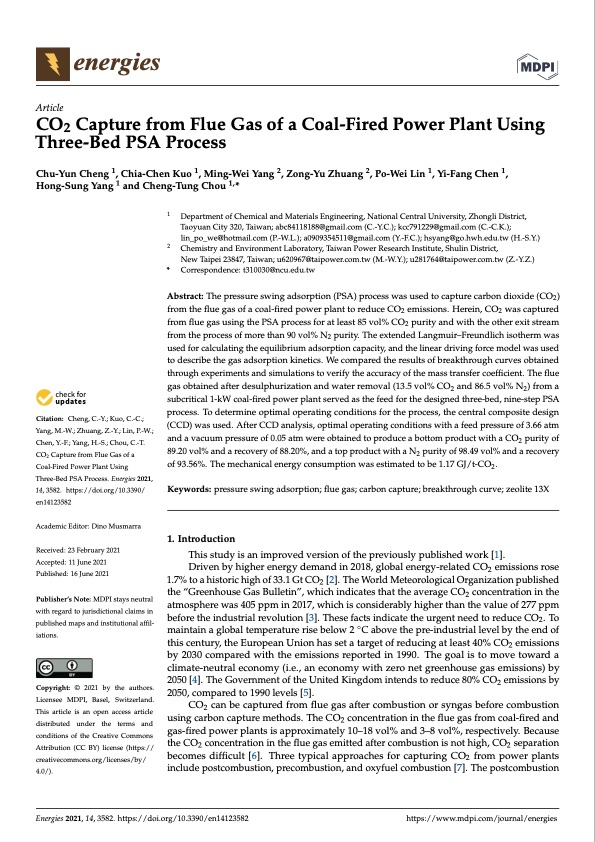
PDF Publication Title:
Text from PDF Page: 001
* Correspondence: t310030@ncu.edu.tw Abstract: The pressure swing adsorption (PSA) process was used to capture carbon dioxide (CO2) from the flue gas of a coal-fired power plant to reduce CO2 emissions. Herein, CO2 was captured from flue gas using the PSA process for at least 85 vol% CO2 purity and with the other exit stream from the process of more than 90 vol% N2 purity. The extended Langmuir–Freundlich isotherm was used for calculating the equilibrium adsorption capacity, and the linear driving force model was used to describe the gas adsorption kinetics. We compared the results of breakthrough curves obtained through experiments and simulations to verify the accuracy of the mass transfer coefficient. The flue gas obtained after desulphurization and water removal (13.5 vol% CO2 and 86.5 vol% N2) from a subcritical 1-kW coal-fired power plant served as the feed for the designed three-bed, nine-step PSA process. To determine optimal operating conditions for the process, the central composite design (CCD) was used. After CCD analysis, optimal operating conditions with a feed pressure of 3.66 atm and a vacuum pressure of 0.05 atm were obtained to produce a bottom product with a CO2 purity of 89.20 vol% and a recovery of 88.20%, and a top product with a N2 purity of 98.49 vol% and a recovery of 93.56%. The mechanical energy consumption was estimated to be 1.17 GJ/t-CO2. Keywords: pressure swing adsorption; flue gas; carbon capture; breakthrough curve; zeolite 13X 1. Introduction This study is an improved version of the previously published work [1]. Driven by higher energy demand in 2018, global energy-related CO2 emissions rose 1.7% to a historic high of 33.1 Gt CO2 [2]. The World Meteorological Organization published the “Greenhouse Gas Bulletin”, which indicates that the average CO2 concentration in the atmosphere was 405 ppm in 2017, which is considerably higher than the value of 277 ppm before the industrial revolution [3]. These facts indicate the urgent need to reduce CO2. To maintain a global temperature rise below 2 ◦C above the pre-industrial level by the end of this century, the European Union has set a target of reducing at least 40% CO2 emissions by 2030 compared with the emissions reported in 1990. The goal is to move toward a climate-neutral economy (i.e., an economy with zero net greenhouse gas emissions) by 2050 [4]. The Government of the United Kingdom intends to reduce 80% CO2 emissions by 2050, compared to 1990 levels [5]. CO2 can be captured from flue gas after combustion or syngas before combustion using carbon capture methods. The CO2 concentration in the flue gas from coal-fired and gas-fired power plants is approximately 10–18 vol% and 3–8 vol%, respectively. Because the CO2 concentration in the flue gas emitted after combustion is not high, CO2 separation becomes difficult [6]. Three typical approaches for capturing CO2 from power plants include postcombustion, precombustion, and oxyfuel combustion [7]. The postcombustion energies Article CO2 Capture from Flue Gas of a Coal-Fired Power Plant Using Three-Bed PSA Process Chu-Yun Cheng 1, Chia-Chen Kuo 1, Ming-Wei Yang 2, Zong-Yu Zhuang 2, Po-Wei Lin 1, Yi-Fang Chen 1, Hong-Sung Yang 1 and Cheng-Tung Chou 1,* Citation: Cheng,C.-Y.;Kuo,C.-C.; Yang, M.-W.; Zhuang, Z.-Y.; Lin, P.-W.; Chen, Y.-F.; Yang, H.-S.; Chou, C.-T. CO2 Capture from Flue Gas of a Coal-Fired Power Plant Using Three-Bed PSA Process. Energies 2021, 14,3582. https://doi.org/10.3390/ en14123582 Academic Editor: Dino Musmarra Received: 23 February 2021 Accepted: 11 June 2021 Published: 16 June 2021 Publisher’s Note: MDPI stays neutral with regard to jurisdictional claims in published maps and institutional affil- iations. Copyright: © 2021 by the authors. Licensee MDPI, Basel, Switzerland. This article is an open access article distributed under the terms and conditions of the Creative Commons Attribution (CC BY) license (https:// creativecommons.org/licenses/by/ 4.0/). 1 Department of Chemical and Materials Engineering, National Central University, Zhongli District, Taoyuan City 320, Taiwan; abc84118188@gmail.com (C.-Y.C.); kcc791229@gmail.com (C.-C.K.); lin_po_we@hotmail.com (P.-W.L.); a0909354511@gmail.com (Y.-F.C.); hsyang@go.hwh.edu.tw (H.-S.Y.) Chemistry and Environment Laboratory, Taiwan Power Research Institute, Shulin District, 2 New Taipei 23847, Taiwan; u620967@taipower.com.tw (M.-W.Y.); u281764@taipower.com.tw (Z.-Y.Z.) Energies 2021, 14, 3582. https://doi.org/10.3390/en14123582 https://www.mdpi.com/journal/energiesPDF Image | CO2 captured from flue gas using the PSA process

PDF Search Title:
CO2 captured from flue gas using the PSA processOriginal File Name Searched:
energies-14-03582-v2.pdfDIY PDF Search: Google It | Yahoo | Bing
CO2 Organic Rankine Cycle Experimenter Platform The supercritical CO2 phase change system is both a heat pump and organic rankine cycle which can be used for those purposes and as a supercritical extractor for advanced subcritical and supercritical extraction technology. Uses include producing nanoparticles, precious metal CO2 extraction, lithium battery recycling, and other applications... More Info
Heat Pumps CO2 ORC Heat Pump System Platform More Info
| CONTACT TEL: 608-238-6001 Email: greg@infinityturbine.com | RSS | AMP |